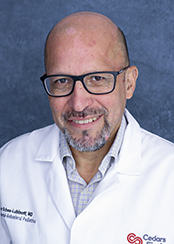Cedars-Sinai Blog
Answers for Children With Angelman Syndrome
Mar 26, 2024 Victoria Pelham

Watching a toddler struggle to learn to walk and talk is painful. It’s even tougher for families when the cause is an incurable genetic disorder.
Angelman syndrome, a rare neurodevelopmental condition, is hard to recognize. Few pediatric neurologists are familiar with the condition, which affects about 500,000 people around the world. And since it has similar symptoms to more widespread, better-known conditions, such as autism and cerebral palsy, it’s initially misdiagnosed in half of all cases, according to the Angelman Syndrome Foundation.
Angelman syndrome is caused by a genetic error and is not inherited. It strikes unpredictably, leaving most families of children with the condition in the dark until the children are around 3 to 4 years old—after they have started preschool and have already fallen behind.
"Less than 1% of Angelman cases have a visible genetic change on a standard test. However, using a combination of newer genetic tests, we can now find the underlying genetic cause in about 90% of cases—dramatically speeding up diagnosis."
"These children have medical and behavioral challenges that are often severe," said Cesar Ochoa-Lubinoff, MD, director of the Angelman Syndrome Clinic at Cedars-Sinai Guerin Children’s. “Families need a lot of resilience and support to cope and help their child access the best possible treatments and outcomes.”
In February, Guerin Children’s launched the clinic—the first such treatment center in Los Angeles—with Ochoa-Lubinoff at the helm. Doctors are also collecting data to better understand Angelman syndrome.
"It’s a complex condition that affects different systems, and current treatments are insufficient," said Ochoa-Lubinoff, who oversees Developmental and Behavioral Pediatrics at Cedars-Sinai Guerin Children's.
Cesar A. Ochoa-Lubinoff, MD, MPH
Missing Milestones
Newborns with Angelman syndrome might have trouble latching or swallowing milk. After a few months, the babies still can’t lift their own heads. Then they lag in sitting up alone, crawling, standing up and taking their first steps. In mild cases, children with the condition start walking at around 2 to 3 years old. Others don’t walk until after their fifth birthday and remain slow, stiff and shaky.
Silence can also be an early red flag. Babies with Angelman syndrome rarely coo. As they grow, they might pick up individual words like “Dada” and respond to their name and basic commands, but they often can’t string together sentences and conversations. As a result, they rely more on nonverbal cues.
"The gap in development widens over the years," Ochoa-Lubinoff explained.
In addition to delays, the condition causes seizures in around 86% of patients, according to the Angelman Syndrome Foundation. Among young people with the condition, these bursts of brain electricity tend to show up by age 3 or in early adolescence, and they sometimes don’t respond to medication.
Children who have Angelman syndrome also are vulnerable to accidents due to seizures, poor balance and lack of danger awareness. A predisposition to impulsivity and hyperactivity also ups their risk.
Eating is often difficult for these kids, as well, because they may experience pain while digesting food.
Other Angelman syndrome symptoms include:
- Intellectual disabilities
- Tremors
- Muscle and movement disorders
- Sleep disturbances
- Gastrointestinal problems, such as constipation and acid reflux
- Difficulty regulating behavior and emotions
Steps to Earlier Diagnosis
If your child’s pediatrician notices significant developmental delays or if your child has a seizure, the pediatrician will refer them to a neurologist and geneticist for a full evaluation.
The genetic variants that lead to Angelman syndrome are hard-wired before birth. The gene responsible for coding a protein that regulates key brain processes such as motion and communication malfunctions and fails to produce the protein.
"Less than 1% of Angelman cases have a visible genetic change on a standard test. However, using a combination of newer genetic tests, we can now find the underlying genetic cause in about 90% of cases—dramatically speeding up diagnosis," said Pedro Sanchez, MD, director of Pediatric Medical Genetics at Cedars-Sinai Guerin Children’s.
Genetic testing is the best way to detect the condition and distinguish it from autism when a child is still young, and it should be discussed at the child’s diagnostic consultation.
"It’s really important to get diagnosed earlier, because we are starting to have treatments," Ochoa-Lubinoff said.
Pedro A. Sanchez, MD
Treating the Whole Child
Pediatric Angelman syndrome specialists use a multidisciplinary approach that is tailored to each child and spans gastroenterology, diet, developmental medicine, neurology, social work, and speech, physical, and occupational therapies.
Most patients need long-term anti-seizure medications or more advanced seizure treatments. Other medications help control unusual, unrelated jerky movements and tremors.
To combat insomnia, specialists emphasize a consistent routine and sleep hygiene, including sleep supplements and medications. In addition, behavioral therapies can teach parents to guide their children to better manage sensory processing, anxiety, anger and energy.
Communication devices are a key tool in the treatment arsenal, according to Ochoa-Lubinoff. Assistive programs on tablets or computers use pictures, symbols, letters and speech generators to fill in language gaps, helping Angelman syndrome patients communicate wants and needs.
"They frequently understand more than they can express," he explained.
Bright Smiles
Progress is often painstakingly slow, and patients with Angelman syndrome are dependent on round-the-clock care and support for the rest of their lives.
But, in the future, experimental medications could redefine or even cure Angelman syndrome.
Researchers are currently studying gene therapies that could help people with the condition produce the crucial protein they are missing. Targeting the genetic source could correct a host of brain and nervous system effects.
Ochoa-Lubinoff hopes to bring clinical trials for these and other drugs to the new Angelman Syndrome Clinic at Guerin Children’s and then expand treatment access widely.
One hallmark of children with Angelman syndrome is their ever-present smiles and bouts of laughter.
"New care options could bring them and their families joy," Ochoa-Lubinoff said.





